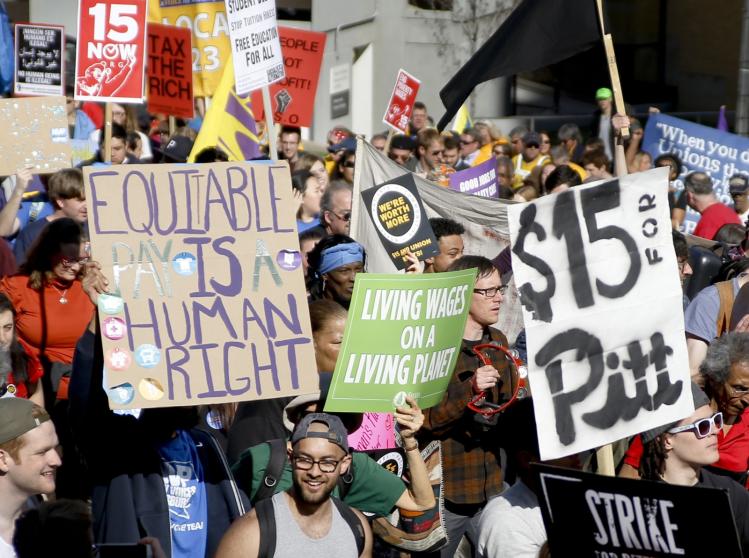
In his latest book, Hell to Pay, the prolific public intellectual Michael Lind offers a compelling analysis of an urgent problem: too many American workers earn too little and lack the bargaining power to demand more. Workers, Lind argues, have been living through a decades-long suppression of wages that is exacerbating “a number of seemingly unrelated social pathologies, from delayed or failed marriage and non-marriage to the decline of civic associations and the rise of identity politics and political polarization.” If we hope to ameliorate any of these problems, we must find a way to increase worker bargaining power.
That this argument comes from someone who cut his teeth in the Republican Party of Ronald Reagan, who did more to weaken worker bargaining power than any other president, will not surprise those familiar with the arc of Lind’s career. A native Texan who did graduate work in international relations at Yale University before earning a law degree at the University of Texas, Lind took his first jobs at the Heritage Foundation and George H. W. Bush’s State Department. During the Clinton era, he embarked on a journalistic career at Irving Kristol’s National Interest, Andrew Sullivan’s New Republic, and Tina Brown’s New Yorker. He famously broke with most of his former associates in Up from Conservatism: Why the Right is Wrong for America (1996), skewering Republicans for waging cynical culture wars only to gain enough power to advance policies benefiting the wealthy few. In 1999, Lind added policy entrepreneurship to his résumé, cofounding the New America Foundation (now New America), where he advocated policies intended to make the U.S. economy more competitive. In recent years, he has taught at the Lyndon B. Johnson School of Public Policy at the University of Texas–Austin.
Along the way, Lind published ten books on politics, policy, and history, the last of which, The New Class War: Saving Democracy from the Managerial Elite (2020), laid the foundation for Hell to Pay. In The New Class War, Lind argued that Western democracies faced an existential threat due to the shortsighted, self-serving mismanagement of their out-of-touch elites. Unless they forged a new class compromise that addressed the needs of workers, Lind warned, democracies would collapse and be replaced by caste-based societies ruled by either a technocratic “overclass” or the kind of populist authoritarians foreshadowed by Trumpism. In Hell to Pay, Lind continues this line of argument, insisting that increased worker bargaining power is a prerequisite for any democracy-sustaining class compromise.
Hell to Pay is suffused with a moral passion that makes it more than a policy brief. “No one who works full time should be poor,” writes Lind. And as long as there are some goods and services such as health care “that should be available to all citizens regardless of ability to pay,” then “the government should pay for them directly or indirectly.” His palpable anger at policies that keep workers poor and deny them access to goods that every human deserves imparts propulsive power to his prose.
As befits someone with an apostate past, Lind is at his best when debunking the dogmas that dominate elite thinking. He makes quick work of human-capital theory’s assertion that workers’ wages simply reflect their skills or lack thereof. The powerful have “taken that theory to heart,” he suggests, primarily because it “shifts responsibility for low wages from employers or government policies” to workers themselves. With equal verve, he demolishes employer claims of labor shortages (when they say they “can’t find enough American workers what they really mean is they cannot find enough Americans willing to work at the wages they prefer to pay,” he writes) and scolds higher education for abetting a debt-driven “credential arms race” in which the “master’s degree is the new BA.”
Unlike most economists, Lind takes seriously the disparity of power embedded in the relation between employer and employee. As Adam Smith famously observed, “In the long-run, the workman may be as necessary to his master as his master is to him; but the necessity is not so immediate.” Lind’s appreciation of the ways in which employers exploit that imbalance of necessity is a distinguishing feature of his analysis.
In recent decades, Lind demonstrates, employers have used their power to hold down wages through several mechanisms. These include “salary bands,” tacit agreements through which multiple employers collude in establishing pay scales for similar jobs; no-poach agreements, in which employers refrain from hiring each other’s workers at higher salaries; non-compete clauses, which currently prevent an estimated 18 percent of U.S. workers from seeking similar work from another employer; forced arbitration, in which more than half of non-union private-sector workers are required, as a condition of employment, to give up any right to sue their employer for wage theft or other abuses; and “gig work,” through which employers outsource jobs to “independent contractors” who lack benefits.
A strength of Lind’s account is that it doesn’t blame wage suppression solely on employers. Effective wage suppression requires government support. While outdated labor laws and the anti-union decisions of the Roberts Court have been undermining workers’ bargaining power, Lind reminds us that the “anti-worker welfare state” plays an important role as well. The U.S. welfare state, he argues, “privatizes the benefits of cheap labor and socializes the costs.” A prime illustration of this, he contends, is the Earned Income Tax Credit, through which taxpayers subsidize low-wage work at some of the country’s largest employers. According to one 2013 study, 60 percent of public assistance to low-waged workers went to employees of just ten companies. A pro-worker welfare state, by contrast, would have robust social-insurance provisions that provide for workers when they are unemployed, retired, or when they leave paid employment to engage in the necessary work of caregiving. The failure of the United States to provide income replacement to new parents, Lind argues, is not only anti-family but anti-worker.
So, what is to be done? Lind’s answer to this question is refreshingly clear: worker bargaining power must be enhanced by a combination of revived union organization and government action. This answer could potentially win Lind many allies. Unfortunately, his arguments in favor of specific remedies seem calculated to repel rather than to attract friends, a problem exacerbated by snide asides aimed at old foes like Paul Krugman, liberal icons like Barack Obama, and, of course, “performative woke leftism.”
Consider his caricature of the union movement, which ought to be one of his strongest allies. Lind is plainly nostalgic for the “pure and simple” unionism of Samuel Gompers that “avoided political partisanship and focused narrowly on achieving a few objectives for workers and kept a safe distance between organized labor and political parties.” He sees today’s labor movement, by contrast, as one in which “dominant public sector unions” exert outsized influence over “vestigial private sector unions” in a movement “wholly subordinated to the Democratic Party.” Lind draws an unfavorable contrast between the tough-minded Gompers and today’s AFL-CIO president, Liz Shuler, whom he takes to task for objecting to the Supreme Court’s Dobbs decision with a statement asserting that working women “must be able to control our own bodies—which has a direct impact on economic justice and the ability of working people to make a better life for themselves and their families.” According to Lind, Shuler’s statement told workers “whose views on abortion differ from those of the left wing of the Democratic Party” that they are “unwelcome in the AFL-CIO.”
Such passages suggest that their author has studied unions hastily and from afar. Gompers, for example, was scarcely the narrowly focused nonpartisan that Lind paints. It was his 1906 “Labor’s Bill of Grievances” that began labor’s search for political alliances—a search that would lead to a courtship between the AFL and the Democrats that Gompers advanced through behind-the-scenes support for Woodrow Wilson in 1912 and public support for his reelection in 1916. It is also inaccurate to say that public-sector unions dominate labor today. There are still more private-sector than public-sector union members. (Indeed, Shuler herself hails from the “vestigial” building trades.) Nor does Shuler’s position on reproductive rights constitute a litmus test for membership in the AFL-CIO. The movement’s membership has never been in lockstep on any big social or political issue. And although Lind claims that a rising tide of working-class conservatism represents a reaction to what he derisively calls “the Great Awokening,” the truth is that working-class conservatism is as old as the labor movement itself and was as much a force in Gompers’s time as in ours.
Lind wishes for “a new and nonpartisan” labor movement. Yet labor’s history—including the factors that led to its alliance with the Democrats—can’t be wished away, nor can a new movement just be wished into being. To achieve the laudable goals to which Lind aspires would require joining hands with the actually existing movement, whose elected leaders he would apparently prefer to lecture on the dangers of woke-ism.
Alas, Lind’s positions on labor law and immigration are no better suited to enlisting allies. He hopes that the “defeated and defective Wagner Act system is allowed to wither away,” but he does not advocate—or even mention—labor’s preferred reform, the Protect the Right to Organize (PRO) Act, or the promising ideas recently advanced by the Clean Slate project at Harvard Law School, which urged expanding the scope of collective bargaining to address common-good issues such as climate change. This would have “appalled and alarmed” Gompers, Lind claims. Instead, Lind proposes extending the nation’s oldest and most restrictive collective-bargaining law, the 1926 Railway Labor Act (RLA), beyond its current scope in railways and airlines. He does so on the dubious theory that the RLA is more conducive to fostering sectoral bargaining (the Clean Slate project also supports sectoral bargaining). Lind’s suggestion that the RLA’s extension could promote meaningful sectoral bargaining is scarcely supported by its history. It failed to foster sectoral bargaining in the airline industry. On the railroads, meanwhile, it created sectoral bargaining without worker leverage. As the 2022 rail crisis reminded us, by making it virtually impossible to strike, the act has undermined unions’ resistance to “precision scheduled railroading,” a managerial technique that has eroded both labor and safety standards (see “Supplicant or Partner?,” January 2023).
Finally, Lind insists that “it is intellectually dishonest to ignore the harm done” by massive legal and illegal immigration to American wage-earners “from farmworkers and janitors to professionals in the tech service.” He cites numerous studies that suggest that immigration places downward pressure on American wages. To be sure, many of these studies are sound, as are Lind’s critiques of the much-abused H-1B work-visa program. But his analysis lacks any sense that immigrants themselves can become a vital force in reviving worker bargaining power. Tellingly, he cites the example of immigrants’ wage-depressing impact on the commercial cleaning workforce of Los Angeles in the 1980s while failing to mention that in the 1990s the same immigrants unionized through the Justice for Janitors campaign and have since made LA a union stronghold. While the extent of immigrants’ historical impact on wages is debatable, their centrality to any future labor revival is not.
It’s encouraging that a public intellectual of Michael Lind’s prominence and talent has joined the battle against wage suppression. That scourge is every bit as threatening to our future as he claims. Hopefully, this will not be his last word on the subject. Before he writes again, though, he would be wise to talk with—rather than snipe at—the potential allies who might join his crusade to strengthen worker bargaining power. Doing so would help model the “transactional politics focused on the day-to-day concerns of typical working families” that he seeks.
Hell to Pay
How the Suppression of Wages Is Destroying America
Michael Lind
Portfolio
$29 | 240 pp.
Please email comments to [email protected] and join the conversation on our Facebook page.
Previous Story
Three Poems by Joan Rohr Myers
Next Story
Is ‘Bronze Age Pervert’ Born to Rule?

